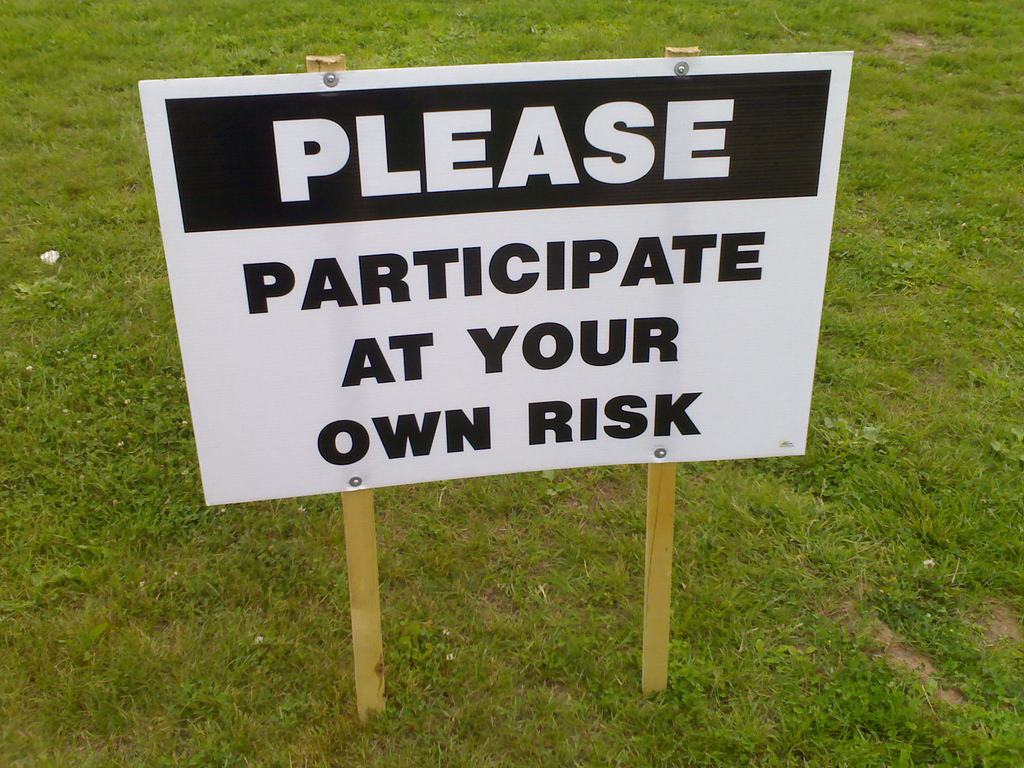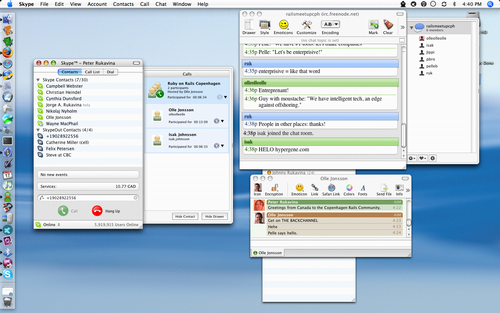If you’ve ever been out with Kevin O’Brien and seen him order a cup of tea, you’ll recall his explicit instructions to the server that the tea be served with actual boiling water.
I’d always thought this habit a bit neurotic on Kevin’s part, but after having had an opportunity in Europe to regularly be served tea made this way, I now understand completely.
Tea made with boiling water — as opposed to merely “hot” water that’s been sitting around all day on top of a Bunn-o-matic is simply much, much better tea.
And so I apologize to Kevin for thinking him neurotic, and encourage one and all to request the boiled.
As a side note, I wonder if it’s actually possible to make good tea any more now that many of us have switch to the “auto shut-off” kettles.
As another side note, I’ve suddenly realized that when I ordered “chá com leite” in Portugal this was most often being interpreted as “I’d like some tea, and I’d like some milk.” As a result I was served a pot of tea and a pitcher of hot milk. And paying for both. Mind you tea made with boiling water to which hot milk is then added is absolutely fantastic, and worth the price. But the question remains: how does one order “tea with a little milk” in Portugal.
 With some helpful pointers from the Apache on Series 60 folks, I’ve been able to set up my Nokia N70 mobile phone to share the Internet connection of my iMac. While it’s not a “mobile data” solution — I still have to be within Bluetooth range of my iMac to use it — it’s an excellent stop-gap measure that lets me explore the mobile web without paying thousands of dollars in data charges.
With some helpful pointers from the Apache on Series 60 folks, I’ve been able to set up my Nokia N70 mobile phone to share the Internet connection of my iMac. While it’s not a “mobile data” solution — I still have to be within Bluetooth range of my iMac to use it — it’s an excellent stop-gap measure that lets me explore the mobile web without paying thousands of dollars in data charges.
I’ve put together a little tutorial that goes through the steps I took to get this working reliably for me. The whole process has something of a “doing your own brake job on your car” feel to it. But it does work, and with some fiddling you can make it work reliably in your setup.
Cynthia Dunsford has written a nice synopsis of her trip to Les Îles de la Madeleine that should serve as a good introduction to anyone thinking of visiting (the most common response you get from Islanders when you ask them if they’ve ever been is “we really want to go over someday”).
About ten years ago Catherine and I went over with our friends Mike and Yvonne from Halifax. It rained for the three days we were there, but we had a good time anyway. At the time — and I suspect this is still true — it was much like one imagines PEI to have been like for the tourist 40 years ago.
After a season-to-date of excellent service at Cafe Diem, Oliver and I fell into a hole of inattentiveness this evening when we stopped by for an after-supper bit of dessert: we sat outside, and dutifully waited for a server to take our order — just like the sign says. And yet, despite at least two and perhaps three servers swirling around us, and many “we’d like to order now” looks their way, we were ignored.
After ten minutes of this we decided we couldn’t take it any more and we got up and left.
The fire of disgruntle burning inside me, I decided that this would be the day I plucked up my courage and went inside Just us Girls, the coffee shop cum trendy urban boutique located just around the corner on Queen St.
To this point a combination of fear of disrupting a private inner sanctum combined with a latent fear of suave young women had kept me away from the place. The promise of a refreshing sounding agua fresca on the sandwich board, combined with the aforementioned fire in belly, and reassurances earlier in the week from Catherine that, despite the name, men were welcome too, was enough to help me overcome all that.
On an evening when Prince St. is coursing with beer-fueled shirtless young men looking to bust heads, Just Us Girls turned out to be the perfect place to hide out: the likelihood of teen youth gangs breaching the gauntlet of pink underwear and dayglo sandals was extremely low and we were in what amounted to the safest place downtown tonight.
The agua fresca was indeed refreshing, Oliver’s strawberry smoothy was similarly so, and the warm brownie we split (and devoured in about 35 seconds) was excellent. The service, suave though it may have been, was kind and helpful. And the men’s washroom (yes, they have one) is quite striking, and has a chair inside the stall which is pretty helpful for fathers of newly-peeing children. Given my earlier preconceptions, we couldn’t have felt more welcome.
Just Us Girls isn’t for everyone; but if, like me, you’re never going to feel comfortable at Bobby MacMillan’s and you’re looking for a place to hide out, it fits the bill pretty well.
Still no reports from the Royal Tandoor. I phoned over to see if they had a menu for take-out or delivery, but they said they’re only offering a buffet for the time being and those things are to come later. Let me know if you’ve eaten there.
The July issue of The Buzz has an ad for a new coffee shop in Founder’s Hall on the Charlottetown waterfront; is this the Campbell Webster operation reported to be going down there, or is that still to come?
In other coffee-shop news, the new Barristas place on University Avenue is only open from 7:00 a.m. to 3:00 p.m., emulating the Cora’s “breakfast and lunch only” style. But they don’t serve wild fruit dishes like Cora’s does.
Meanwhile, Cora’s reopened this week after a brief closure — reportedly to switch franchisees.
The highfalutin Rustico restaurant Dayboat (actually it’s “dayboat,” e.e. cummings style) has a full-colour, full-page ad in The Buzz too, which seems sort of like Trying Too Hard (if it’s so great, why do they need to advertise?). I’ve had two reports of bad Dayboat meals so far this year; if you’ve had a good (or bad) meal there, please report in.
Oh, and the Formosa Tea House is closed on July 1.
One of the big practical challenges of leaving home for 6 weeks as we did earlier this year is figuring out how to pay the bills: who wants to come home to find the car repossessed and the electricity cut off?
As it turns out, it was a lot easier than I thought it would be.
On the business front I made sure that there were signed cheques in place to cover the corporate income tax and payroll remittance bills — the two unforgiving federal “we will charge you more penalties than you can possibly believe” bills. Johnny helpfully made sure the checks went to the right place at the right time.
At home, I paid all the outstanding bills the day before we left on May 8th, made our property tax bill payment online on May 31st, and paid our credit card balances online too as we traveled.
While there was a giant pile of mail waiting for us when we arrived back home on June 21st, nothing was extremely past due, and most bills were just waiting for the next regular payment. So, no problem.
If we were going to be away for 2 or 3 months — Berlin 2007? — we’d have to make more complicated arrangements, as the bills would simply pile up too high.
You’d think, given the tightly packed bunch of friends I have living around the University Avenue corridor here in Charlottetown, that it would be hard to suddenly sneak an Indian restaurant into our midst. But this morning we all woke up and where two days ago there was an apparently empty storefront — the former home of the Forbidden Palace — there is now Royal Tandoor:

Of course, once it was there, the reports into the editorial offices here didn’t stop. I don’t know anyone who’s eaten there, but we’re all shaking in anticipation. Dan and Steven are even talking of “Tandoor Tuesdays.” Reader reports welcome.
You can find location and hours information on the Royal Tandoor page in the Rukapedia.
Olle writes about Copenhagen Garden Houses:
A koloni-have (“colony garden”, a garden lot with a wee house, organized in a sort of garden club, or association) is golden in these parts. The house on it can be made into a little summer house, with bed and bathroom, and they seem a little less restricted than the Swedish ones I have seen.
This situation there seems quite similar Les Marais in Bourges, where “des cabanes de tôles ou de planches” are scattered about the marshes below the main city.
The back page of the June YANKEE magazine has a nice piece by Edie Clark, available here, where she describes her old “little cottage on a lake:
Not too much money and a place to be near the water, which provides summer solace, heat relief and a steady show of living watercolors.
The summer cottages I remember most fondly are the little one-room places you used to be able to stop at on road trips. There was one between downtown Peterborough and Trent University (anyone remember the name?), another in North Bay that we used to stop at on the way up to Cochrane to see my grandparents. Catherine and I stopped south of Rumford, Maine a few years ago and stayed overnight at a small camp on Lake Kezar that rented wee cabins. They had a ping-pong table and rowboats. It was wonderful.
So I’m sitting here this afternoon in my office and I notice that Olle is providing live blog commentary from the Copenhagen Rails Meetup. I ping Olle and he invites me to the IRC backchannel (#railsmeetupcph on irc.freenode.net), where I suggest he add a webcast, which is forthwith arranged by Olle over Skype. Here’s what it all looks like:
Except for the annoying tendency of Danes to speak Danish, it’s all a reasonable approximation of “being there.” Of course there’s no beer here, but then I wouldn’t drink beer even if there was.


 I am
I am